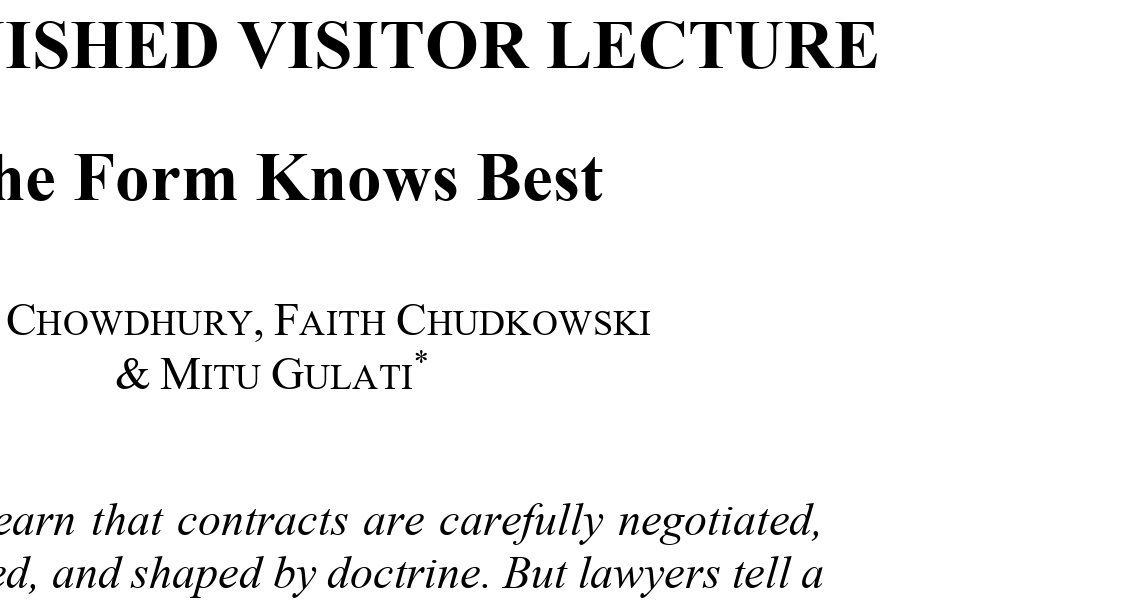
Recently I encountered this law review article: Tara Chowdhury, Faith Chudkowski & Mitu Gulati, The Form Knows Best, 79 U. of Miami L. Rev. 607 (2025). In this post, I explain two quibbles. I also suggest that the reality the authors describe is better explained by copy-and-pasting, as opposed to being driven by forms.
The Article
In their article, Chowdhury, Chudkowski, and Gulati—two law students and a professor—explore the lessons of 170 or so interviews. Those interviews were conducted as part of research projects studying different sets of contract provisions in mergers-and-acquisitions, leveraged-loan, and sovereign-bond deals, provisions that had been identified as problematic.
The authors identify six “myths” regarding how lawyers draft contracts—“gaps between the Official Story and the Unofficial One we heard throughout our interviews.” Here’s my summary of those “myths,” using a combination of the authors’ words and my own, with the label used to identify the myth followed by a statement of what the authors consider the reality:
- Myth 1, Words Matter: Contract language is perpetuated mindlessly and no longer has a generally-accepted definition.
- Myth 2, Case Law Equals Sacred Text: Most transactional lawyers don’t read cases and don’t update contracts to reflect caselaw.
- Myth 3, History Is Irrelevant: The implications of provisions aren’t assessed deal by deal. Instead, provisions are copied from one contract to another.
- Myth 4, Bargain Theory Controls: Parties don’t bargain over the pricing of flawed provisions. Instead, they’re accepted as part of a form.
- Myth 5, Culture Matters Not: Drafting isn’t driven exclusively by the imperatives of the deal. Instead, it reflects local culture, institutional inertia, and market norms.
- Myth 6, Every Provision Is Tailored. Deal terms aren’t carefully revised to reflect the interests of the parties. Instead, they’re cobbled together with little review, to get deals done quickly.
The authors go on to say that these myths support “an alternative way of understanding transactional documents. Not as bespoke instruments finely tuned to every possible contingency in the deal at hand—but as historical artifacts, shaped by inherited forms and market convention.”
Two Quibbles
I have two suggestions regarding how Chowdhury, Chudkowski, and Gulati describe their myths and reality.
First, myths 3 through 6 are in fact the same myth, “Every Provision Is Tailored.” For one thing, myth 3, History Is Irrelevant, explains that myth by saying, “Every contract provision is tailored to the needs of the parties for the deal in question.” That foreshadows the wording of myth 6, Every Provision Is Tailored. Myths 4 and 5 use different words but also are equivalent to myth 6. The authors offer a different reality for each myth, but in presenting each of those four myths as distinct, the authors muddy their analysis.
And second, the reality accompanying myths 5 and 6 would seem to countenance a variety that goes against the authors’ apparent focus on the role of forms, which is most obvious in the title of the article: Myth 5’s reality offers a role for local culture, and according to myth 6’s reality, “contractual provisions are cobbled together from various prior deals and precedents, often without much review.” And elsewhere the authors refer to “provisions” without making it clear whether they have in mind provisions in forms or any provisions, whatever the context. The rest of this article takes the title of their article at face value—the focus is on the role of forms.
The Broader Context
I suggest that the reality Chowdhury, Chudkowski, and Gulati observed isn’t due to the role of forms, and it’s not limited to the three kinds of deals that were the focus of the interviews the authors conducted. Instead, it’s attributable to the fact that contracts have long been drafted by copy-and-pasting, on faith, from precedent contracts and templates of questionable quality and relevance. Few of us have the time, expertise, or resources to draft contracts from scratch. To some extent, we’re all cranking the handle of the copy-and-paste machine.
Saying we’re in thrall to copy-and-pasting is different from attributing primacy to forms. For one thing, a given form could conceivably be the product of bespoke drafting rather than copy-and-pasting.
Furthermore, because M&A, leveraged-loan, and sovereign-bond deals are lower-volume and higher value, they’re more likely to be form-driven than everyday commercial contracts, but all contracts are overwhelmingly likely to be products of copy-and-pasting, either entirely or largely. A deal might offer some opportunity for customizing, or it might offer a lot. That’s consistent with Chowdhury, Chudkowski, and Gulati’s account of the reality underlying myth 5, Culture Matters Not, and myth 6, Every Provision Is Tailored.
Copy-and-pasting gives rise to the behaviors noted in the article. Due to generation after generation copy-and-pasting, it’s likely anyone working on a given contract will be unable to explain what some part of that contract means. It’s also likely that some part of that contract is irrelevant, unclear, or is unnecessarily wordy. If you don’t understand something in a contract, it’s likely you’ll be nervous about removing it, no matter how confusing or irrelevant it is. If it’s been around long enough, you might accept it as part of the scenery, no matter how archaic it is.
It has generally been the case that copy-and-pasters haven’t received rigorous training in what to say in contracts and how to say it. They’re also unlikely to consult caselaw, or commentary on caselaw (more about that in a future post). But many of them are willing to rely on addled conventional wisdom dreamed up by the legalistic mind in an attempt to attempt to explain that which doesn’t make sense.
So thanks to the copy-and-paste system, it’s likely that any given contract is dysfunctional to the point of being embarrassing. There’s a good chance it might even be a disgrace.
I don’t get the sense that Chowdhury, Chudkowski, and Gulati think the dysfunction is as broad and systemic as I do. As evidence for the scale of the dysfunction, I invite you to browse the 600-plus pages of A Manual of Style for Contract Drafting (5th ed. 2023), which explores how drafters say whatever they want to say in a contract. If you want an example of the cumulative effect of that kind of dysfunction, go here to download a 2021 Word document containing (1) six extracts from the Salesforce master subscription agreement that are extensively annotated by me to describe the drafting shortcomings and (2) my reworked version of each extract. To pick just one example of dysfunction in what to say in a contract, go here for my 2013 article on the successors-and-assigns provision. For an example of what-to-say and how-to-say-it dysfunction in a single contract, see this 2023 blog post for my analysis of Practical Law’s mutual confidentiality agreement. For my thoughts on an M&A contract, see this 2013 blog post.
I could go on and on. The nature and scale of the dysfunction is undeniable.
Again, the dynamic on display in Chowdhury, Chudkowski, and Gulati article is better explained by copy-and-pasting rather than the primacy of forms—copy-and-pasting is systemic in the drafting of all kinds of contracts. And because of copy-and-pasting, mainstream contract drafting is an embarrassment.

Ken, I agree.
But I think there are additional reasons for why it all happens.
1. The profit motive. Biglaw transactional partners (who set the approach of the firm) no longer have a collective ethos of being professionals first and foremost. They primarily want to make shedloads of money. Money is made by processing big deals quickly, not by spending time on legal details.
2. Security in numbers. If everyone else is following “market” trends, you are less likely to be criticised for a failure to exercise independent judgment.
3. No training in contract drafting. The use of office templates and computerisation have combined to make original drafting a quaint, artisanal activity.
5. Clients choose the best brand, not the best lawyers. Big clients of biglaw aren’t criticised for choosing the brand name.
6. That’s what insurance is for. If there really is a big problem with the quality of the law firm’s work, it will be covered by insurance, or the firm can swallow the damages from their enormous profits.
7. In the UK market, there is an additional safeguard. You farm difficult questions of law out to a barrister in private practice, and then follow their advice. [NB some big US clients are alive to this, and require the solicitors’ firm to co-sign counsel’s advice.]
Hi Mark. Everyone has been copy-and-pasting since forever, so it’s a systemic problem. Yes, some will be more astute than others in protecting themselves, but that doesn’t make it any less systemic. Doubtless the factors you mention are relevant, but they build on the systemic problem, and it’s well nigh impossible to determine that, for example, someone is going all-in on slapdash copy-and-pasting so they can be more profitable.
The thought occurs to me that the tort standards for professional malpractice tend to favor the defendant who complies with standard industry practices, rather than best practices (with some exceptions, maybe in engineering). This, of course, rewards the cut-and-paste crowd. If that standard were to change, insurance companies might be the leading edge in getting law firms to adopt MSCD-type drafting standards. It might take just one or two big M&A-related lawsuits. Look what happened to M&A practice on letters of intent after Marty Lipton lost big in Texas (sorry, it was a long time ago and I don’t remember the name of the case, but Lipton had drafted a LOI that the Texas court held was enforceable because it didn’t say it wasn’t, so Lipton’s client had to pay the breakup fee).